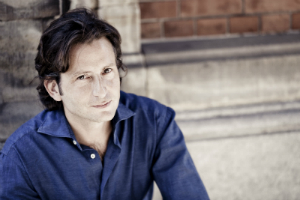by Timothy Robson

He seems to be working his way up the ladder through engagements with European regional orchestras, so this “one-off” debut concert with The Cleveland Orchestra — undoubtedly with very limited rehearsal time — put him under a laser light in three masterworks: Beethoven’s Leonore Overture No. 2 and Piano Concerto No. 5, “Emperor,” with the esteemed Garrick Ohlsson as soloist, and Dvořák’s Symphony No. 8.
Gimeno came through unscathed with sensible performances and, from an audience member’s point of view, a solid conducting career ahead of him.
Beethoven struggled to complete his only opera, Fidelio, and during the course of its composition he wrote three different overtures, all of which he ultimately discarded in favor of a much shorter one. The three leftovers, known as the Leonore overtures (after the opera’s original title), have become standard concert works.
The second of these overtures gives a sense of both the opera’s drama and some of its themes, with ominous opening chords and a slow, delicate second section. Gustavo Gimeno conducted with a light touch, keeping things moving along briskly, but not rushed. The interplay among the winds was emphasized. The sudden trumpet fanfares from offstage interrupted the proceedings but made us aware of the portent of the opera’s philosophical themes: captivity and freedom.
Garrick Ohlsson is a giant, both in his commanding physical presence and as a performer. For many years he has been a frequent, welcome guest of The Cleveland Orchestra, with many meritorious performances to his credit, and this evening’s reading of Beethoven’s “Emperor” Concerto was no exception. The usual virtues of Ohlsson’s playing were all present: an aristocratic style, precision, musicality, and virtuosity — though never just to be flashy. He was in complete control of the score, from its thundering octave passages to its most delicate pianissimo.
The first movement is the longest, and such was the grandeur of the performance that one could feel many in the audience fighting back the urge to applaud. The adagio second movement, with its exquisite melody, was all about lyricism and the interplay between soloist and orchestra. A short transition leads directly into the third movement, a rondo, and Ohlsson and Gimeno brought out Beethoven’s good humor in the movement, with its joyous, leaping main theme. Gimeno was an attentive accompanist, deferring to the soloist in the balance between piano and orchestra.
Even in the stormiest sections of the first movement of Dvořák’s Symphony No. 8, in Gimeno’s hands lyricism was never far away. He led with with a fine sense of pulse and flexible phrasing. The second movement, “Adagio,” is very episodic, but Gimeno managed to create a coherent totality. The third movement — not the usual scherzo — is a gracious waltz to begin, and later resembles a folksong of Dvořák’s native Bohemia.
The movement ends abruptly, seguing immediately into the famous trumpet fanfares that open the final movement, a set of variations. The evening’s cheerfulness continued as the theme was vdeveloped. The passage in which the brass reprise the opening fanfares, but this time above the rest of the orchestra, is surely one of the most thrilling in symphonic music. It was electrifying here. Again, Gimeno led with confidence and allowed the details of the music to emerge. Dvořák takes a long time to get to the final cadence, with several points where he could have ended, and he strings us listeners along for maximum dramatic effect.
The evening proved full of listening enjoyment. We may not have the true mark of Gustavo Gimeno’s skill as a conductor, but he acquitted himself here with honor, and his will be a career to watch. We may well be able to say, “We heard him when…”
Photo by Marco Borggreve
Published on ClevelandClassical.com August 11, 2015.
Click here for a printable copy of this article



